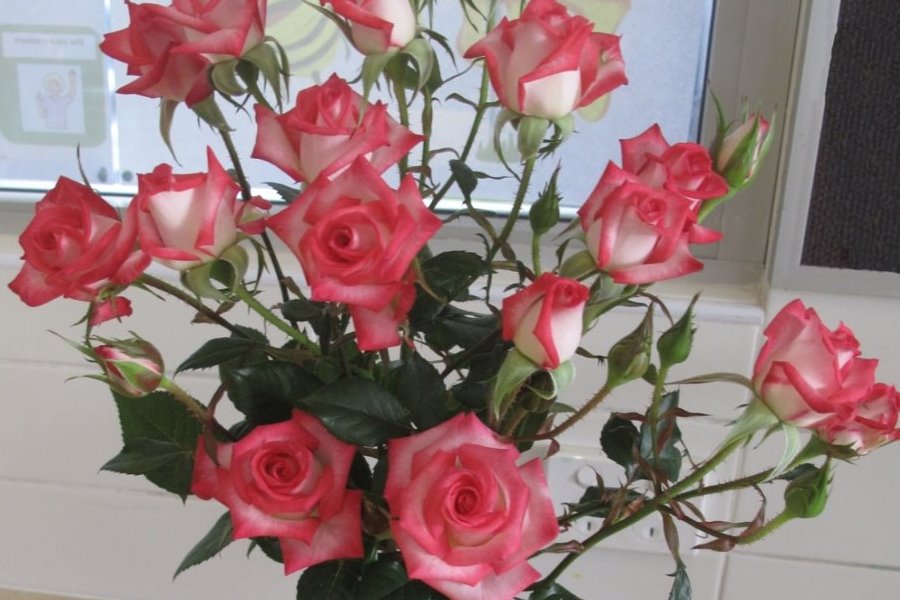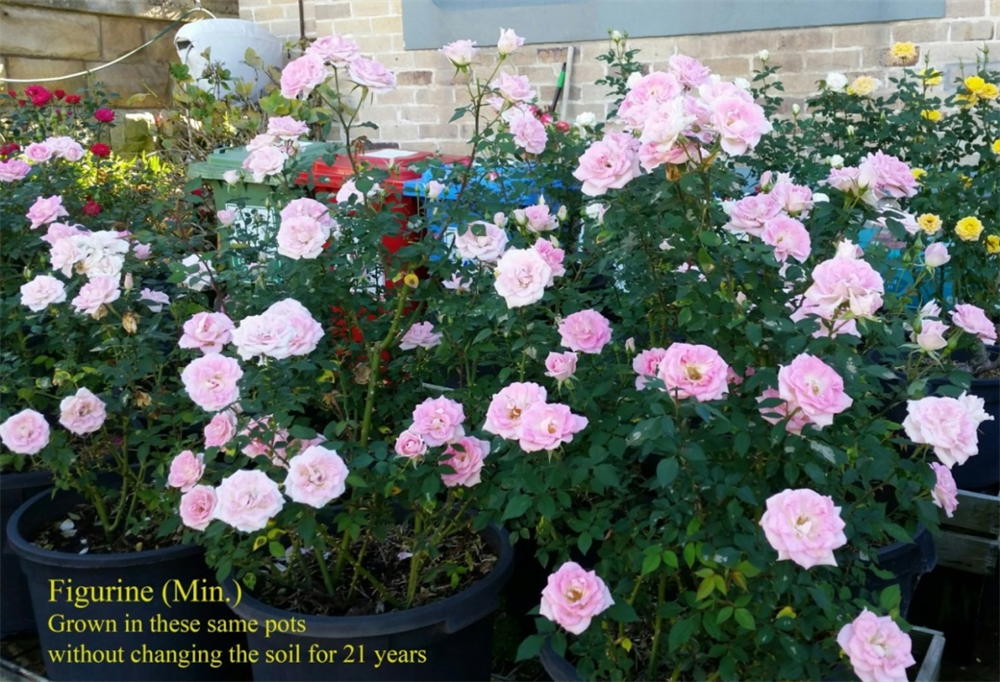Growing Potted Roses with Mark McGuire

Mark McGuire of Sydney, Australia, is the most successful exhibitor of Miniature and Mini-Flora roses in New South Wales in the last twenty seven years. Over this time, his list of success is commendable and includes the honour of Judge for eighteen years, Chairman of Judges for eight years in NSW and holds the record for winning the most Championship Ribbons at the Royal Easter Show with 22 out of 32 being available in 2012.
Mark now grows about 400 roses of all varieties, reduced from 600 including about 50 miniatures (all in pots) at his home in Kurraba Point, Sydney. About 80% of these are all grown on the nature strip/verge in his street. North Sydney Council has placed a bronze plaque on the street in front of Mark's home for having a Garden of Excellence.
Mark shares with us his preferred method of growing miniature potted roses.

Please note that this is my preferred method of growing miniature or mini-flora roses in pots. As I have had remarkable results over the last 25 years of growing, these methods that I suggest are worth trying.
Before I go on any further there is no magic formula, be it soil mixtures, fertilizers or whatever. Rosarians still succumb to the belief that there is …well I don’t know of any!
One should first of all pay particular attention to hygiene and safety. A face covering mask and gloves are essential as potting mix contains many organisms that are or can be detrimental to one’s health.
For best results a black plastic container of 400 mm or 16 inches is my preferred size. Yes, you can still use smaller pots; however the results will not be as good. If you were to drive around your suburb on rubbish collection day then maybe you can be lucky enough to acquire them for free. I have accumulated some 100 or more pots over the years this way.
Make sure you thoroughly clean out the pots that you intend to use and that they have several weep holes so as the water can easily disperse. Otherwise the roots will become water logged and your bare rooted rose will suffer accordingly and perhaps soon die. Another good idea is to use some shade mesh or pieces of broken tiles or some such matter placed over the weep holes as this will stop your soil mixture leaching out the bottom.
My preferred mixture is to use a high quality potting mix such as one of the better Debco products, costing around $12-$15 or so. This 30 litre bag usually contains Saturaid wetting agent, controlled release fertilisers, water retaining crystals, and combination of trace elements and growth stimulants. Sounds marvellous. Remember you only get what you pay for. You will notice on nearly all bags of Potting Mix on sale now have the Australian Standard Certificate printed on the bag, which is a rectangle of some 5 ticks on a red label for the premium mix which is what I suggest you use for best results. When you see 5 ticks on a black label means you are getting a standard type mixture. The larger Supermarkets sell these for around the $4-5 mark. So now you have your premium potting mix and from here I suggest you buy some premium garden soil. Mix together in approximately 50-50 proportions and add a few handfuls of the Neutrog product Seamungus, which is a blend of seaweed, fish, huric acid and manure. This is an Australian product and no doubt those living overseas can source a similar product.
Next place your mixture in the pot leaving about a 100 mm gap between the top of the soil and the rim of the pot. Place in your bare rooted rose, or if taken from a smaller pot, check over the root system for any damage and if so trim back. Fan out the roots and place the plant into the soil making sure the bud union is slightly above the top of your soil mix. Over time the soil will descend in the pot. With limited pressure make sure the plant is sitting firmly in the centre of the container. Apply a couple of soakings of water and then add about 50mm of cow manure, making sure it is kept well away from the trunk of the rose, and then place on top of the manure as much Lucerne hay as the pot will allow without spilling all over your yard.
Cow manure is by far the best to use and readily available whereas Lucerne hay (Alfalfa) is head and shoulders above any other mulch. So yes, during the growing season keep topping up your pots with these two products. Yes, you may have to pay a little extra with the results being worthwhile. Do not be misled by the Nurseries as they tend to steer you onto an alternate product which will be cheaper. No doubt you wish for results that are worthy of all your effort, so this is my recommendation.
By using this method you will induce worms to multiply and greatly benefit your soil mix. Take note there is no soil in potting mixtures and therefore no worms. If your garden has an abundance of worms it will mean your soil is rich and productive and that is what you need in your pots. Pure garden soil in a pot would soon become too solid and detrimental to the growth of your plant. To stop your pot from overheating be sure your newly potted plant container is not making contact with the concrete or tiles underneath. Raise your pot by using a few small bricks or small terracotta feet that can readily be purchased in the Nurseries. Never place your pot in a saucer type dish that will retain water as this will also eventually lead to root rot.
When do we need to feed? I suggest after potting/planting a good six months or so. Very little fertiliser is best. If the manufacturers recommend 100 grams then only apply about 20% of that every couple of months. I recommend that you use a liquid fertiliser rather than pellets or granules. Whatever you do, be sure to give the pot a good drenching before hand and a good soaking afterwards. Water is still the best fertiliser!
If you wish to grow the bigger Floribunda’s or Hybrid tea roses then follow the same procedure as above. You will need to use a rather large pot something about the size of a half beer barrel, which is about 20 litres, (9 gallons).
When do we re-pot? Rarely ever have I done so. None of my pots have been re potted over the last 25 years and yet my results are great, or so I think!
It is necessary to water your pots every day and in really hot weather, twice per day. Don’t be misled that when rain appears that your pots do not need watering…how wrong can you be! The combination that I have recommended for your pots is best served by using a hand held rose wand making sure the water spreads all over the top of the pot. If you tend to use a drip type system you will soon notice that it tends to make what I refer to as “ant tracks”. Meaning the water flows down these little tracks without spreading over the whole mix, this is not what you want. The nutriments contained need a good soaking all the time. No, don’t go looking for ants…this is just a saying.

Recently on the ABC’ 702 gardening show a caller rang in with what I believed was this problem. She fertilised and watered regularly over the last few years and now all her leaves were falling off and die back was occurring. Yes, she said the water was running out the pot rather fast. I concluded that her watering was not making contact with the fertilisers she was using and subsequently a build-up of them was happening or perhaps the pots were becoming dry. Due to the fact that the plant could not take up all this accumulated food she was creating her own problems.

Lastly you will need to check the pH of your potted soil every so often or if you suspect why the plant is not performing as it should. The ideal pH is 6.5 to 7. This is rather hard to accomplish as I have never been able to achieve a higher reading than 6.3. Below pH 7 the soil is acidic and rose’s best perform when so. Whilst above pH 7 the mix is considered alkaline. I have two different manufacturers pH kits so that I can compare my results. However I must admit they both give identical readings of the same soil. There are some rather inexpensive test kits available and they can last forever. Follow the instructions and if you are having a problem consult the horticulturist at your local nursery.
In most cases when seeking advice always approach the top person in that particular field whether it is the exhibitor, judge, breeder, soil environmentalist or whoever. Most are only too willing to offer advice, so do not be afraid to ask.
If you wish to become competitive by exhibiting in Shows then you have to devote much more time to your roses. People such as Roger Federer, or anyone else in their chosen field never became famous without going on and taking that extra step to achieve their goals. More effort will render better results.
With winter pruning there is no right or wrong way. Prune high or low as the results will be nearly identical. Low pruning appears to give more water shoots whereas cutting higher tends to produce more flowers. Keep your bushes clear of deadwood and dieback during the growing season, whilst you must dead head regularly (removing spent blooms). They look good on the bush however they are detrimental to the future growth and reproduction of more flowers.
Be aware some roses do not like pots. I have struck this problem on many occasions. Once placed out in the garden they have taken off and become Grand Champions!!






